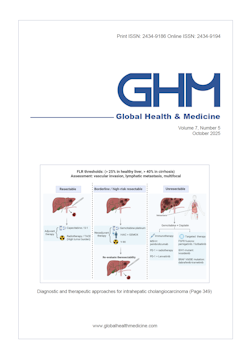Global Health & Medicine 2025;7(5):384-390.
Coronary artery stenosis in Japanese hemophiliacs living with HIV-1 progressed dramatically over two years
Nagai R, Gatanaga H, Uemura H, Ogata M, Kubota S, Yamamoto M, Hara H, Oka S, Hiroi Y
Patients with hemophilia living with HIV-1 are at increased risk for coronary artery disease (CAD) due to overlapping factors, including chronic vascular inflammation, antiretroviral therapy–associated dyslipidemia, and reduced physical activity from hemophilic arthropathy. However, longitudinal data on cardiovascular outcomes in this population have been scarce. In this two-year longitudinal follow-up study, 58 patients were evaluated. The cohort was stratified into three groups based on baseline CCTA findings and treatment history: 47 with normal-to-mild stenosis, 3 with prior PCI or CABG, and 8 with moderate-to-severe stenosis. Among the moderate stenosis group, 7 underwent repeat CCTA, and 4 showed progression of coronary lesions. Of these, 3 developed severe stenosis requiring percutaneous coronary intervention (PCI), despite improvement in LDL-C through pharmacologic and lifestyle interventions. Overall, LDL-C significantly decreased (p < 0.05); however, pulse wave velocity (PWV), an indicator of arterial stiffness, worsened in about half of patients. In the revascularization group, PWV deterioration was significant (p = 0.017). Our earlier cross-sectional analysis of this population demonstrated that a considerable proportion had moderate-to-severe stenosis requiring intervention, underscoring the need for longitudinal assessment. These findings suggest that even under guideline-based cardiovascular management, there remains a considerable risk for CAD progression in HIV-infected hemophilia patients with moderate or greater stenosis. Therefore, repeat CCTA at two-year follow-up could be considered to facilitate early detection and guide timely intervention. Continuous monitoring, including imaging, and early intervention targeting modifiable risk factors may be important to reduce long-term cardiac risk in this vulnerable population.
DOI: 10.35772/ghm.2025.01100







